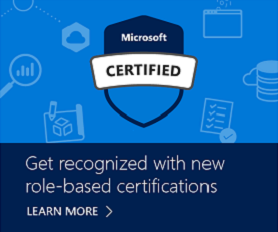Note
Access to this page requires authorization. You can try signing in or changing directories.
Access to this page requires authorization. You can try changing directories.
Posted 10 Nov 2017 by Liberty Munson (Microsoft)
More than a year ago, I introduced a new item type that is a series of multiple choices questions that state a problem, a potential solution, and then ask you to indicate if the solution solved the problem (by selecting "Yes") or not (by selecting "No"). We'll call them Yes/No questions. They are on many of our exams, and if you've recently taken an exam, you have seen them.
The goal of this question type is to evaluate whether or not you can determine a correct solution to a problem when you see it. You should be able to do this without reference to other possible solutions that you would see if this a typical multiple choice question with the usual accoutrement of 3 or more answer choices. After all, in the real world, you are not presented with multiple solutions that you get to select from . . . well, at least not in the artificial way they are presented in multiple choice questions. You may have to brainstorm multiple solutions, and then pick the best one; but, if a solution makes your list for consideration, odds are high that it has some chance of solving the problem, rather than our typical distractors that won't.
Why am I blogging about this again? As many of you know, I read all the comments on our beta exams and good selection of them on our live exams. And, although we have clear instructions preceding these items about what to expect, most of the comments are along the lines of "I didn't know that I wouldn't be able to review/return to the question." So, I thought this was worth another blog to see if I could increase awareness about this experience.
I completely understand that you may not like that you can't return to questions, review, and possibly change your answer. I get it. That being said, I see the value in this type of question because it really assesses whether you recognize if a solution will actually solve the problem without relying on test taking strategies that allow some to "game" their way into the correct answer without actually knowing it. So, to address the second most common comment that I read—we should be allowed to return to questions and change our answers—actually defeats the purpose of this item type. Removing the ability to return to items is by design. Many of you are smart enough to eliminate at least one distractor; some of you can eliminate two simply by comparing them to each other. It's an age-old test taking strategy that allows people to increase the odds of answering a question correctly even when they don't know the answer. But, if I'm going to certify you or call you an "expert," I need to be sure you really do have the necessary skills and abilities. This question type allows me to do that.
Some tips for answering these questions:
Preceding these questions is an overview page with the following information.
Tip #1: Read it!
In this section, you will see one or more sets of questions with the same scenario and problem. Each question presents a unique solution to the problem, and you must determine whether the solution meets the stated goals. More than one solution might solve the problem. It is also possible that none of the solutions solve the problem.
After you answer a question in this section, you will NOT be able to return to it. As a result, these questions will not appear in the review screen.
Tip #2: Do NOT overthink these questions. Everything that you need to know to answer the question is in the problem statement. Don't make these questions more complicated by overthinking. By the way, this is good advice in general about all of our exam questions. We are NOT trying to trick you. If the solution doesn't completely solve the problem or is just the first step, the answer is "no." It doesn't solve the problem. It's as simple as that.
Tip #3: If you don't know, make your best guess. You can't return to these questions so any answer is better than no answer.
I hope this helps clarify why these Yes/No questions are on our exams, and you are better prepared for what to expect when you encounter them. I am planning to create an item tutorial specific to this question type and work with our practice test providers to ensure that these question types on our practice exams.
If you have other ideas on how to improve this experience (other than allowing you to return to them or removing them), let me know. I completely understand your dislike of them, but I hope you better understand their value in validating your knowledge, skills, and abilities and why they are on our exams.
